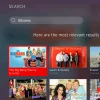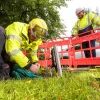UK ISP BT Tops 9.2 Mill Broadband Users and BDUK Sees Clawback Boost
The latest quarterly (Q3 2016 calendar) results have been published by BT today, which reveal that their retail broadband base now tops 9,193,000 customers (up by +76K, unchanged from Q2) and 4,473,000 of those take their ‘Infinity‘ (FTTC/P) superfast broadband (up by +216K vs +181K in Q2).
As usual it’s been another busy quarter for the BT Group, which seems to have expended most of its energy on regulatory battles with Ofcom and rival ISPs. Elsewhere they unveiled a massive pilot of their 300Mbps capable G.fast broadband service with 140,000 UK premises (here and here) and confirmed their intention to begin the roll-out of IPv6 (here).
Advertisement
On top of that Openreach’s engineering teams have continued the roll-out of “fibre broadband” (FTTC/P) services across the United Kingdom, which can now reach around 26 million premises (mostly via the slower ‘up to’ 40-80Mbps FTTC technology) and that equates to about 92% coverage. Otherwise BT’s financial situation looks to have held up well, albeit with a few weaker areas.
Key Highlights from Today’s Quarterly Report
* BT Groups’ quarterly revenue hit £6,007m (up from £5,775m in Q2 2016)
* BT Group’s reported profits before tax hit £671m (down from £717m)
* BT Group’s half-year net debt to 30th Sept hit £9,573m (up from £5,919m last year)
* BT Wholesale’s quarterly operating profit hit £129m (up from £123m)
* Openreach’s quarterly operating profit hit £297m (down from £300m)
* Openreach’s quarterly capital expenditure hit £357m (up from £337m)
We should also highlight the latest situation with regards to BT’s capital expenditure and clawback / gain share from via the Government’s Broadband Delivery UK roll-out programme, which suggests that nearly £300m of public funding may now be available for reinvestment into future “fibre” expansion.
Capital Expenditure
Capital expenditure was £802m (Q2 2015/16: £629m). This consists of gross expenditure of £815m (Q2 2015/16: £691m) which has been reduced by net grant funding of £13m (Q2 2015/16: £62m) mainly relating to our activity on the BDUK programme.
Our base-case assumption for take-up in BDUK areas remains at 33%. Under the terms of the BDUK programme, we have a potential obligation to either re-invest or repay grant funding depending on factors including the level of customer take-up achieved. While we have recognised gross grant funding of £34m (Q2 2015/16: £90m) in line with network build in the quarter, we have also deferred £21m (Q2 2015/16: £28m) of the total grant funding to reflect higher take-up levels on a number of contracts. To date we have deferred £292m.
Now let’s take a closer look at BT’s different divisions.
BT Consumer / Retail
As highlighted in the first paragraph, BT’s consumer division has continued to add new broadband customers and fibre growth improved over the previous quarter. The positive movement most likely reflects a combination of attractive special offers / advertising, as well as students signing up for new contracts after the summer and an initial subsiding of fears around the Brexit vote.
Advertisement
| Broadband Subs | TV Subs | Mobile Subs + EE |
Fibre Subs | |
| Q3 2016 TOTAL |
9,193,000 | 1,684,000 | 30,248,000 | 4,473,000 |
| Subs Change (Q3) | +76,000 | +64,000 | -20,000 | +216,000 |
| Q2 2016 TOTAL |
9,117,000 | 1,620,000 | 30,268,000 | 4,257,000 |
| Subs Change (Q2) | +76,000 | +59,000 | -177,000 | +181,000 |
It’s worth pointing out that BT’s own customers continue to account for the lion’s share of “fibre broadband” (FTTC/P) subscribers on Openreach’s national network, but we’ll cover that below.
Openreach & Wholesale
The results from Openreach are very useful because they offer an overview of the wider market, at least in respect to BT’s national UK network and those independent ISPs that buy services over it (i.e. the total broadband and “fibre” lines below combine customers from BT Consumer and many other ISPs that buy their lines from Openreach).
Note: Unbundled (LLU) lines are mostly used by ISPs (e.g. TalkTalk and Sky Broadband) that have installed some of their own kit inside Openreach’s network in order to gain more control over their own products and services. In that sense MPF lines are more popular because they afford ISPs the most control and flexibility to differentiate themselves.
| Total UK Broadband Lines |
Fully Unbundled MPF Lines |
Shared Unbundled SMPF Lines |
Fibre Lines (FTTC/P) |
|
| Q3 2016 TOTAL |
20,119,000 | 8,950,000 | 1,094,000 | 6,679,000 |
| Subs Change (Q3) | +116,000 | +16,000 | +27,000 | +440,000 |
| Q2 2016 TOTAL |
20,003,000 | 8,934,000 | 1,067,000 | 6,239,000 |
| Subs Change (Q2) | +95,000 | +13,000 | +8,000 | +333,000 |
Perhaps the most interesting figure to take away from Openreach’s summary is the quarterly increase of +440K in new “fibre broadband” (FTTC/P) lines, which of course includes the +216K added via BT’s Consumer division. In other words, BT’s retail rivals (e.g. Sky, TalkTalk, Zen Internet etc.) accounted for +224K of the total quarterly increase (up sharply from +152K the previous quarter). We should also point out that the SMPF total above includes external fibre services on BT WLR (Wholesale Line Rental) lines.
Advertisement
Separately, BTWholesale delivered a total of just 882,000 external broadband lines for other ISPs, which has fallen by -3,000 in the quarter.
Gavin Patterson, CEO of BT Group, said:
“This is a positive set of results, both operationally and financially, and we remain on track to achieve our full year outlook. We’ve made good progress on the integration of EE and the delivery of our synergy targets. Our consumer facing lines of business have performed well, but in the enterprise space, UK public sector continues to be a challenging market.
Across the group, we continue to drive cost reduction and productivity improvements. Customer experience remains a key priority, and we’re stepping up our investments in the second half of the year. And we’ll continue to invest in our ultrafast and 4G plans in 2017 and beyond.
Ofcom’s consultation on the Digital Communications Review closed earlier this month; we’ve submitted our response and will continue to engage with Ofcom to reach the best outcome for the UK.”
Overshadowing today’s report is of course the question of Openreach’s future. In an ideal world Ofcom and the BT Group would have reached a voluntary agreement by now, but instead both sides appear to have become entrenched, not least over the endlessly divisive issue of governance.
On one hand the regulator wants Openreach to become a “legally separate company“, which would be accountable to BT’s board (not BT Group’s CEO) and could make its own investment decisions. On the other hand BT views this as going too far and they’re worried about the related costs / risks of moving staff and pension liabilities to the “new” company (BT’s pension deficit is a staggering £9.5bn net of tax!).
Ofcom could of course push the nuclear button and force through a full separation, but that is likely to trigger a complicated divorce and would surely attract a lot of lawyers. In the end this remains the single most important issue for the BT Group to resolve and until they do then any progress in other areas might not attract as much attention.
Speaking of progress in other areas, BT also confirmed that its move to answer 90% of customer service / support calls in the United Kingdom has now completed. Similarly EE has answered 100% of EE postpaid calls in its UK and Ireland contact centres.
On the subject of EE, the mobile business has now expanded its geographic 4G network coverage to 70% of the UK (98% population coverage) and they aim to reach 92% by September 2017, followed by 95% by the end of December 2020. The 4G customer base also reached 17.6 million.
Mark is a professional technology writer, IT consultant and computer engineer from Dorset (England), he also founded ISPreview in 1999 and enjoys analysing the latest telecoms and broadband developments. Find me on X (Twitter), Mastodon, Facebook, BlueSky, Threads.net and Linkedin.
« BT Publish First UK Prices for the 160-330Mbps G.fast Broadband Pilot

















































Comments are closed